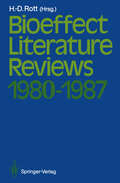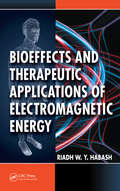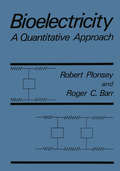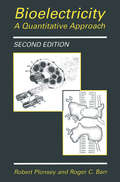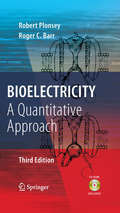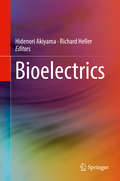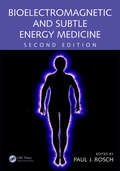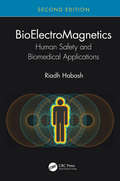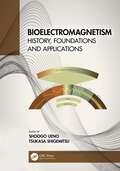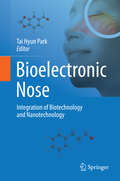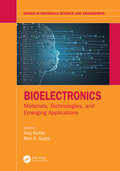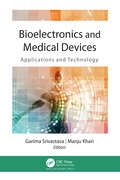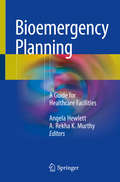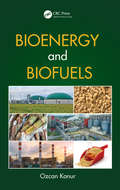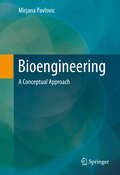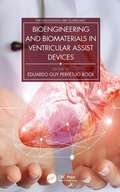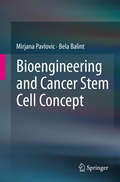- Table View
- List View
Bioeffect: Literature Reviews 1980–1987
by Hans-DieterRottDiagnostic ultrasound has been in clinical use for more than 25 years, during which time it has been introduced into nearly all clinical disciplines. No substantial arguments for any adverse ef fects have been found. It is therefore commonly accepted that sono graphy is safe and causes no health risks. However, safety is not a property that can be proved experimentally; rather, it is character ized by the absence of detectable adverse effects in various relevant investigations. It is reasonable always to reconsider this assumption of safety by evaluating the latest results of ultrasound bioeffect re search. Thus the European Federation of Societies for Ultrasound in Medicine and Biology (EFSUMB) decided to establish a bio effect group with the task of - assessing existing documentation on the subject - carrying out a continuing review of the literature, particularly in relation to any new evidence that might modify existing conclu sions and recommendations - making reports to the membership on the state of the subject at such times and in such ways as seems appropriate The Watchdog Group was instituted in 1979 and named the Euro pean Committee for Ultrasonic Radiation Safety. It comprises ex perts in the field on an interdisciplinary basis, including physicists, biologists, gynecologists, and a geneticist. Since its formation the Watchdog Group has met once a year to discuss relevant topics. Its activities include the composition of reports, statements, and publi cations, as well as the organization of panel discussions.
Bioeffects and Therapeutic Applications of Electromagnetic Energy
by Riadh HabashFrom cell phones to treating cancer, EM energy plays a part in many of the innovations that we take for granted everyday. A basic force of nature, like nuclear energy or gravity, this energy can be harnessed and used, but still holds the potential to be harmful. The question remains, how safe are EM products? Bioeffects and Therapeutic Applicati
Bioelectricity: A Quantitative Approach
by Roger C. Barr Robert PlonseyThis text is an introduction to electrophysiology, following a quantitative approach. The first chapter summarizes much of the mathematics required in the following chapters. The second chapter presents a very concise overview of the general principles of electrical fields and current flow, mostly es tablished in physical science and engineering, but also applicable to biolog ical environments. The following five chapters are the core material of this text. They include descriptions of how voltages come to exist across membranes and how these are described using the Nernst and Goldman equations (Chapter 3), an examination of the time course of changes in membrane voltages that produce action potentials (Chapter 4), propagation of action potentials down fibers (Chapter 5), the response of fibers to artificial stimuli such as those used in pacemakers (Chapter 6), and the voltages and currents produced by these active processes in the surrounding extracellular space (Chapter 7). The subsequent chapters present more detailed material about the application of these principles to the study of cardiac and neural electrophysiology, and include a chapter on recent developments in mem brane biophysics. The study of electrophysiology has progressed rapidly because of the precise, delicate, and ingenious experimental studies of many investigators. The field has also made great strides by unifying the numerous experimental observations through the development of increasingly accurate theoretical concepts and mathematical descriptions. The application of these funda mental principles has in turn formed a basis for the solution of many different electrophysiological problems.
Bioelectricity: A Quantitative Approach
by Robert Plonsey Roger C. BarrIn the first edition of Bioelectricity, Plonsey and Barr provided an introduction to electrophysiology following a quantitative approach. In this second edition they address new discoveries in the field of ion channels. The text is an introduction to electrophysiology utilizing a quantitative approach. It describes the principles of electrical fields, using basic principles from science and engineering while taking the biological applications into consideration. The book thus provides an introduction to the quantitative description of underlying electrophysiology with illustrative application to cardiac electrophysiology and functional electrical stimulation. The book can be used as a bridge to more advanced texts, particularly those that stress a quantitative approach.
Bioelectricity: A Quantitative Approach
by Robert Plonsey Roger C. BarrThis is the new edition of the classic introductory text to electrophysiology. It covers many topics that are central to the field including the electrical properties of the cell membrane and cardiac electrophysiology. Organized as a textbook for the student needing to acquire the core competencies, this book meets the demands of advanced undergraduate or graduate coursework in biomedical engineering and biophysics. New features include extra, detailed illustrations. The book is authored by two eminent biomedical engineering professors at Duke University who discuss many topics that are central to biophysics and bioengineering and the quantitative methods employed.
Bioelectrics
by Hidenori Akiyama Richard HellerThis book focuses on bioelectrics, a new multidisciplinary field encompassing engineering and biology with applications to the medical, environmental, food, energy, and biotechnological fields. At present, 15 universities and institutes in Japan, the USA and the EU comprise the International Consortium of Bioelectrics, intended to advance this novel and important research field. This book will serve as an introductory resource for young scientists and also as a textbook for use by both undergraduate and graduate students – the world’s first such work solely devoted to bioelectrics.
Bioelectrochemical Systems: Vol.1 Principles and Processes
by Prasun Kumar Chandrasekhar KuppamThis book is the first in a two-volume set devoted to bioelectrochemical systems (BESs) and the opportunities that they may offer in providing a green solution to growing energy demands worldwide. In this first volume, established research professionals explain the underlying principles and processes of BESs, providing a thorough introduction to these systems before proceeding to address the roles of cathode catalysts and biocatalysts, biofilms, heterotrophic denitrification, and nanotechnology approaches. This volume forms a sound foundation for understanding the potential industrial applications of this technology, which include in particular the generation of high-value chemicals and energy using organic wastes. These applications are the focus of the second volume, where readers will find up-to-date information on microbial fuel cells and the use of microbial biofilm- and algae-based bioelectrochemical systems for bioremediation and co-generation of valuable chemicals. The book is designed for a broad audience, including undergraduates, postgraduates, energy researchers/scientists, policymakers, and anyone else interested in the latest developments in this field.
Bioelectrochemical Systems: Vol.2 Current and Emerging Applications
by Prasun Kumar Chandrasekhar KuppamThis book is the second in a two-volume set devoted to bioelectrochemical systems (BESs) and the opportunities that they may offer in providing a green solution to growing energy demands worldwide. While the first volume explains principles and processes, in this volume established research professionals shed light on how this technology can be used to generate high-value chemicals and energy using organic wastes. Bioelectricity is generated in microbial fuel cells (MFCs) under oxygen-depleted conditions, where microbial bioconversion reactions transform organic wastes into electrons. Dedicated chapters focus on MFCs and state of the art advancements as well as current limitations. In addition, the book covers the use of microbial biofilm- and algae-based bioelectrochemical systems for bioremediation and co-generation of valuable chemicals. A thorough review of the performance of this technology and its possible industrial applications is presented. The book is designed for a broad audience, including undergraduates, postgraduates, energy researchers/scientists, policymakers, and anyone else interested in the latest developments in this field.
Bioelectromagnetic and Subtle Energy Medicine
by Davis LangdonBioelectromagnetic and Subtle Energy Medicine focuses on a wide variety of evidence-based bioelectromagnetic and subtle energy therapies for disorders ranging from cancer, cardiomyopathy, and Parkinson's disease to depression, anxiety, and pain. Since publication of the first edition more than a decade ago, there have been so many advances in these
BioElectroMagnetics: Human Safety and Biomedical Applications
by Riadh HabashThis book is an educational resource of evolving scientific knowledge in the area of bioelectromagnetics that may serve the interests of students and decision-makers, as well as society as a whole. It is distinguished by extensive descriptions of fundamental biophysical concepts and their relevance to human health. Reflecting the transdisciplinary approach from several different intellectual streams including physics, biology, epidemiology, medicine, environment, risk science, and engineering, the book is quite a venture into the battling studies to assess the latest research on health effects and biomedical applications of EM energy. This new edition of the book particularly looks at the potential threats from the emerging 5G wireless networks, which will deploy large numbers of low-powered smartphones, notebooks, tablets, radio access networks, and other transmitters. Features Introduces necessary biophysical principles of EM fields in the context of their interaction with living systems. Strengthens understanding of cutting-edge research on several major areas in the broad area of bioelectromagnetics. Presents safety standards and guidelines for human exposure to EM fields. Discusses techniques that have been developed to ensure adequate EM-thermal dosimetry required for both health effects and biomedical applications. Provides insight into the determinants of EM health risk assessment and public concerns. Includes extensive reference list at the end of each chapter to enhance further study. Riadh Habash is a special appointment professor and McLaughlin Research Chair in Electromagnetic Fields and Health at the University of Ottawa, Canada. He has been the recipient of many awards, including the National Wighton Fellowship Award, and has authored or co-authored over 90 research articles, six books, and five book chapters. His most recent books are Green Engineering in 2017 and Professional Practice in 2019 (CRC Press), with the remaining previous books targeting the area of bioelectromagnetics.
BioElectroMagnetics: Human Safety and Biomedical Applications
by Riadh HabashThis book is an educational resource of evolving scientific knowledge in the area of bioelectromagnetics that may serve the interests of students and decision-makers, as well as society as a whole. It is distinguished by extensive descriptions of fundamental biophysical concepts and their relevance to human health. Reflecting the transdisciplinary approach from several different intellectual streams including physics, biology, epidemiology, medicine, environment, risk science, and engineering, the book is quite a venture into the battling studies to assess the latest research on health effects and biomedical applications of EM energy. This new edition of the book particularly looks at the potential threats from the emerging 5G wireless networks, which will deploy large numbers of low-powered smartphones, notebooks, tablets, radio access networks, and other transmitters. Features Introduces necessary biophysical principles of EM fields in the context of their interaction with living systems. Strengthens understanding of cutting-edge research on several major areas in the broad area of bioelectromagnetics. Presents safety standards and guidelines for human exposure to EM fields. Discusses techniques that have been developed to ensure adequate EM-thermal dosimetry required for both health effects and biomedical applications. Provides insight into the determinants of EM health risk assessment and public concerns. Includes extensive reference list at the end of each chapter to enhance further study. Riadh Habash is a special appointment professor and McLaughlin Research Chair in Electromagnetic Fields and Health at the University of Ottawa, Canada. He has been the recipient of many awards, including the National Wighton Fellowship Award, and has authored or co-authored over 90 research articles, six books, and five book chapters. His most recent books are Green Engineering in 2017 and Professional Practice in 2019 (CRC Press), with the remaining previous books targeting the area of bioelectromagnetics.
Bioelectromagnetics Current Concepts: The Mechanisms of the Biological Effect of Extremely High Power Pulses (Nato Security through Science Series B:)
by Sinerik N. Ayrapetyan Marko S. MarkovThis volume includes the lectures and selected posters on different aspects of biological effects of EMF, presented at the NATO ADVANCED RESEARCH WORKSHOP “The mechanisms of biological effect Extremely High Power Pulses (EHPP)” (3-5 March 2005) and the UNESCO/WHO/IUPAB Seminar “Molecular and Cellular Mechanisms of Biological Effects of EMF” (1-2 March 2005) that took place in Yerevan, Armenia. The gracious support of several international organizations made possible to bring together 47 scientists, engineers, physicians and policy makers from 21 countries from Europe, North and South America, Asia. The Capital of Armenia, Yerevan, provided an excellent opportunity for discussions of the experimental data and theoretical models of EMF effect on various levels, starting from cell aqua bathing medium to the whole organism, including the human, applying multidisciplinary approaches. The continuous increase of the number of man made EMF sources leads to dramatic changes in the spectrum of EMF in the biosphere. During the last two decades the public concern about potential hazard of EMF generated by power and distribution lines, as well as mobile communications and base stations have initiated serious public concern and has triggered the attention of the WHO, which reflected in the EMF project of harmonization of standards. At the same time, contemporary medicine largely uses EMF diagnostic methods. The beneficial effects of EMF are complemented with a large scale of EMF therapeutic modalities used in a number of countries, helping millions of people.
Bioelectromagnetism: History, Foundations and Applications
by Shoogo UenoBioelectromagnetism has been gradually developing and expanding into a variety of fields in engineering, biomedical engineering, life science, medicine and biology. Bioelectromagnetism: History, Foundations and Applications provides an overview of the field and its developments; from its inception and growth through the twenty-first century, to the latest advances in electro- and magnetobiology and hazard evaluations of electromagnetic fields.It is organized into three sections, each focusing on specific regions of bioelectromagnetism. It begins with the foundations of the field and its history, with a chronological treatment of the major subjects in bioelectromagnetism. The relationship between atmospheric electromagnetic phenomena, geomagnetism and biological systems are presented. It then discusses the many benefits of bioelectromagnetism: electroreception, magnetic navigation, magnetic sense and magnetic responses of plants, birds, animals and humans. It then moves on to human health issues and the impact of bioelectromagnetism. It also provides practical guidance on how to set safety guidelines. Finally, it looks forward to the future prospects of the field based on the latest research in the field.In exploring both the history of the field and the latest developments in today’s research advances, this book provides a comprehensive and self-contained treatment on the subject, which will be a valuable reference for researchers in biophysics, medicine, electrical engineering and biomedical engineering.It can be used as a companion to the editor’s previously published books: Biomagnetics: Principles and Applications of Biomagnetic Stimulation and Imaging (9781482239201, 2016, CRC Press); and Bioimaging: Imaging by Light and Electromagnetics in Medicine and Biology (9780367203047, 2020, CRC Press).Key Features: Provides both a historical view of the field, along with the latest developments in the field Contains practical guidance for researchers on how to set safety guidelines for those working in the area Edited by authorities in the field, with chapter contributions from specialists
Bioelectromagnetism: History, Foundations and Applications
by Shoogo Ueno Tsukasa ShigemitsuBioelectromagnetism has been gradually developing and expanding into a variety of fields in engineering, biomedical engineering, life science, medicine and biology. Bioelectromagnetism: History, Foundations and Applications provides an overview of the field and its developments; from its inception and growth through the twenty-first century, to the latest advances in electro- and magnetobiology and hazard evaluations of electromagnetic fields.It is organized into three sections, each focusing on specific regions of bioelectromagnetism. It begins with the foundations of the field and its history, with a chronological treatment of the major subjects in bioelectromagnetism. The relationship between atmospheric electromagnetic phenomena, geomagnetism and biological systems are presented. It then discusses the many benefits of bioelectromagnetism: electroreception, magnetic navigation, magnetic sense and magnetic responses of plants, birds, animals and humans. It then moves on to human health issues and the impact of bioelectromagnetism. It also provides practical guidance on how to set safety guidelines. Finally, it looks forward to the future prospects of the field based on the latest research in the field.In exploring both the history of the field and the latest developments in today’s research advances, this book provides a comprehensive and self-contained treatment on the subject, which will be a valuable reference for researchers in biophysics, medicine, electrical engineering and biomedical engineering.It can be used as a companion to the editor’s previously published books: Biomagnetics: Principles and Applications of Biomagnetic Stimulation and Imaging (9781482239201, 2016, CRC Press); and Bioimaging: Imaging by Light and Electromagnetics in Medicine and Biology (9780367203047, 2020, CRC Press).Key Features: Provides both a historical view of the field, along with the latest developments in the field Contains practical guidance for researchers on how to set safety guidelines for those working in the area Edited by authorities in the field, with chapter contributions from specialists
Bioelectronic Nose: Integration of Biotechnology and Nanotechnology
by Tai Hyun ParkThe “bioelectronic nose”, the device which has a similar function to the human smell sensing system, can be realized by combining the olfactory cells or receptors with nanotechnology. In the last two decades, much has been learned about the smell sensing mechanism in biological systems. With knowledge about the biological olfactory system and the techniques for the expression of biological receptor proteins, we are able to utilize biological materials and systems to mimic the biological olfactory system. In addition to the advances in biological and biotechnological area, nanotechnology has progressed to a great degree. The bioelectronic nose is a good example of the integration of biotechnology and nanotechnology. This book describes basic biological sciences of the olfactory system, biotechnology for the production of olfactory biological elements, and nanotechnology for the development of various sensing devices. The purpose of this book is to provide the reader with a concept, basic sciences, fundamental technologies, applications, and perspectives of the bioelectronic nose.
Bioelectronics: Materials, Technologies, and Emerging Applications (Series in Materials Science and Engineering)
by Anuj Kumar Ram K. GuptaBioelectronics is emerging as a new area of research where electronics can selectively detect, record, and monitor physiological signals. This is a rapidly expanding area of medical research, that relies heavily on multidisciplinary technology development and cutting-edge research in chemical, biological, engineering, and physical science. This book provides extensive information on the (i) fundamental concepts of bioelectronics, (ii) materials for the developments of bioelectronics such as implantable electronics, self-powered devices, bioelectronic sensors, flexible bioelectronics, etc, and (iii) an overview of the trends and gathering of the latest bioelectronic progress. This book will broaden our knowledge about newer technologies and processes used in bioelectronics.
Bioelectronics: Materials, Technologies, and Emerging Applications (Series in Materials Science and Engineering)
by Anuj Kumar Ram K. GuptaBioelectronics is emerging as a new area of research where electronics can selectively detect, record, and monitor physiological signals. This is a rapidly expanding area of medical research, that relies heavily on multidisciplinary technology development and cutting-edge research in chemical, biological, engineering, and physical science. This book provides extensive information on the (i) fundamental concepts of bioelectronics, (ii) materials for the developments of bioelectronics such as implantable electronics, self-powered devices, bioelectronic sensors, flexible bioelectronics, etc, and (iii) an overview of the trends and gathering of the latest bioelectronic progress. This book will broaden our knowledge about newer technologies and processes used in bioelectronics.
Bioelectronics and Medical Devices: Applications and Technology
by Garima Srivastava, Manju KhariThis new volume provides an abundance of information on new biomedical applications being used today. The book covers a wide range of concepts and technologies, discussing such modern technological methods as the Internet of Things, e-pills, biomedical sensors, support vector machines, wireless devices, image and signal processing in e-health, and machine learning. It also includes a discussion on software implementation for the devices used in biomedical applications. The different types of antennas, including antennas using RF energy harvesting for biomedical applications, are covered as well.
Bioelectronics and Medical Devices: Applications and Technology
by Garima Srivastava Manju KhariThis new volume provides an abundance of information on new biomedical applications being used today. The book covers a wide range of concepts and technologies, discussing such modern technological methods as the Internet of Things, e-pills, biomedical sensors, support vector machines, wireless devices, image and signal processing in e-health, and machine learning. It also includes a discussion on software implementation for the devices used in biomedical applications. The different types of antennas, including antennas using RF energy harvesting for biomedical applications, are covered as well.
Bioemergency Planning: A Guide for Healthcare Facilities
by A. Rekha K. Murthy Angela HewlettThis text gathers the weaknesses revealed during recent infections outbreaks and organizes them into a guide for combating the trends in emerging infections as they relate to hospital preparedness. As the first book to exclusively explore infectious emergencies, the text begins by reviewing potential pathogens and the clinical issues that may threaten hospital safety before delving into the best operational guidelines for commanding a staff under extreme circumstances, including incident command, communication, transport, maintenance, and a myriad of other topics that can remain manageable with proper protocol. Written by experts in the field, this text is the only one that offers the most effective clinical responses to a crisis at every level of care, including special population, laboratory techniques, care of the deceased, behavioral support, and medical documentation. The text concludes by focusing on the reality of care by introducing true examples from the field and the lessons gained from these cases.Bioemergency Planning is a vital resource for infectious disease specialists, hospitalists, epidemiologists, internal medicine physicians, nurses, social workers, public health officials, and all medical professionals who need to be prepared to respond to an infection outbreak.
Bioenergy and Biofuels
by Ozcan KonurThis book aims to inform readers about the recent developments in bioenergy and biofuels covering current issues from an interdisciplinary approach. It will also feature coverage of anticipated future trends related to each particular biofuel. Chapters will consist of original research presented by world class experts in their respective fields. A number of interdisciplinary areas will be incorporated such as Energy & Fuels, Biotechology, Genomics, Economics, Optimization, Chemical Engineering, Mechanical Engineering and Algae Science. Examples will relate to a matrix of biofuel and energy types such as bioethanol, biobutanol, and biomethane.
Bioengineering: A Conceptual Approach (SpringerBriefs in Computer Science #0)
by Mirjana PavlovicThis book explores critical principles and new concepts in bioengineering, integrating the biological, physical and chemical laws and principles that provide a foundation for the field. Both biological and engineering perspectives are included, with key topics such as the physical-chemical properties of cells, tissues and organs; principles of molecules; composition and interplay in physiological scenarios; and the complex physiological functions of heart, neuronal cells, muscle cells and tissues. Chapters evaluate the emerging fields of nanotechnology, drug delivery concepts, biomaterials, and regenerative therapy. The leading individuals and events are introduced along with their critical research. Bioengineering: A Conceptual Approach is a valuable resource for professionals or researchers interested in understanding the central elements of bioengineering. Advanced-level students in biomedical engineering and computer science will also find this book valuable as a secondary textbook or reference.
Bioengineering and Biomaterials in Ventricular Assist Devices (Emerging Materials and Technologies)
by Eduardo Guy Perpétuo BockOften associated with artificial hearts, ventricular assist devices (VADs) are blood pumps that can provide circulatory assistance to the left ventricle, the right ventricle, or both. Bioengineering and Biomaterials in Ventricular Assist Devices reviews constructive details of VADs and the biomaterials used in their development and support. FEATURES Establishes an area of intersection between engineering and medicine Shows process development from mechanical design to automation and control Discusses biofunctional materials, tribology in ceramic biomaterials, biosensors, and surface engineering and blood This text is aimed at advanced students, researchers, and practicing engineers conducting work on VADs and will be of interest to a broad interdisciplinary group, including bioengineers, materials engineers, chemical engineers, mechanical engineers, and electrical engineers.
Bioengineering and Biomaterials in Ventricular Assist Devices (Emerging Materials and Technologies)
by Eduardo Guy Perpétuo BockOften associated with artificial hearts, ventricular assist devices (VADs) are blood pumps that can provide circulatory assistance to the left ventricle, the right ventricle, or both. Bioengineering and Biomaterials in Ventricular Assist Devices reviews constructive details of VADs and the biomaterials used in their development and support. FEATURES Establishes an area of intersection between engineering and medicine Shows process development from mechanical design to automation and control Discusses biofunctional materials, tribology in ceramic biomaterials, biosensors, and surface engineering and blood This text is aimed at advanced students, researchers, and practicing engineers conducting work on VADs and will be of interest to a broad interdisciplinary group, including bioengineers, materials engineers, chemical engineers, mechanical engineers, and electrical engineers.
Bioengineering and Cancer Stem Cell Concept (SpringerBriefs in Computer Science #0)
by Mirjana Pavlovic Bela BalintThis book explores the role of cancer stem cells in the diagnosis, treatment, and cure of cancers. This book also tackles novel methodology for cancer stem cell marker identification, cancer stem cell respiration and metabolism, genetic and epigenetic mechanisms including DNA methylation, and mi-RNA assemble. It also emphasizes the role of Bioinformatics techniques, which provide a novel methodology for modeling cancer outcomes. The authors investigate the difference between cancer stem cells and normal stem cells, along with the concept of targeted cancer stem cell therapy. Although the theoretical explanations of cancer stem cell involvement in leukemia and solid cancers are controversial, there is now little doubt that cancer stem cells exist within otherwise heterogeneous cancer cell population. The brief examines the two leading theories, hierarchical and the stochastic/cancer stem cell model. Researchers, professors and advanced-level students focused on bioengineering and computer science will find this book to be a valuable resource. It is a very good source of critical references for understanding of this problem, and a useful tool for professionals in related fields.
